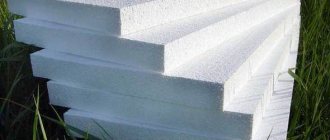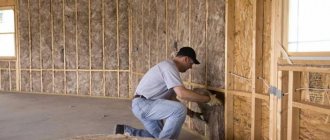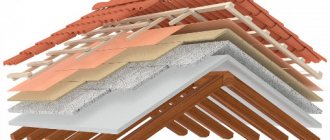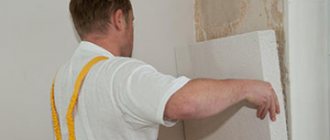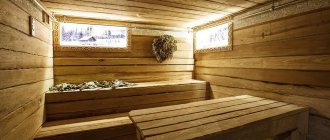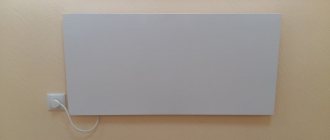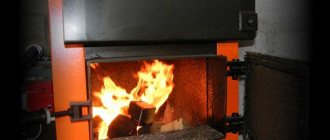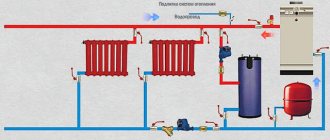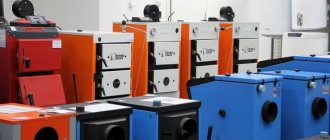Since about 30% of all heat loss occurs through the floor, it needs insulation in the same way as other structural elements of the room - walls and ceiling. The main method of thermal insulation is insulating the floor under the screed.
When insulating under a screed, it is very important to choose the right thermal insulator. Insulation materials such as expanded clay, polystyrene foam, mineral wool, penoplex and polyurethane foam are most often used as insulation for installing a heat-insulating layer under screed. You can also install a floor heating system, which can be infrared, electric or water.
What is the best way to insulate a floor under a screed? We understand the choice of optimal material
Since about 30% of all heat loss occurs through the floor, it needs insulation in the same way as other structural elements of the room - walls and ceiling.
The main method of thermal insulation is insulating the floor under the screed. When insulating under a screed, it is very important to choose the right thermal insulator. Insulation materials such as expanded clay, polystyrene foam, mineral wool, penoplex and polyurethane foam are most often used as insulation for installing a heat-insulating layer under screed. You can also install a floor heating system, which can be infrared, electric or water.
Foam insulation
Insulation with foam plastic sheets is carried out by analogy with floor insulation with penoplex.
You can insulate the floor either with foam plastic slabs or apply a screed with the addition of insulation granules.
When insulating with polystyrene foam granules, they are mixed in a 1:1 ratio with cement and the resulting mixture is poured onto the floor. It should be taken into account that the thermal insulation properties of such a coating leave much to be desired, and the strength characteristics of the floor also decrease.
Insulation with foam plastic sheets is carried out by analogy with floor insulation with penoplex. Sheets of material can be fastened either with adhesives or with dowels.
Penoplex screed - what kind of technology is it?
Penoplex boards have good density and strength; they are not afraid of high loads. Both sand and cement screed and self-leveling mixtures fit well on their flat surface.
Its homogeneous structure is similar to a whole arsenal of small cells measuring 0.2 mm in size. Unlike other insulation materials, it has virtually no vapor permeability and does not absorb moisture. Penoplex is produced by industry mainly in the form of rectangular slabs of different lengths, widths, and thicknesses.
For insulation, you can use not only slabs, but also polystyrene granules, which are sold in bags. Granules are added to the concrete solution to produce polystyrene concrete. But it is more convenient to use penoplex in slabs under floor screed for insulation.
An uninsulated floor leads to increased humidity in the house, which results in the appearance of fungal mold. The room loses up to 20% of heat through cold floors. People suffer from colds and leg joints suffer.
Before insulating floors with foam boards, you need to prepare the base. The concrete base is freed from dirt, potholes and irregularities are repaired. The earthen base is first covered with a sand cushion, and before screeding it is compacted and leveled.
Pros and cons of floor insulation under screed
Compared to other insulation materials, the manufacturing technology of tile penoplex is aimed at protecting the material from moisture absorption. Its closed cell structure gives the material frost resistance and compressive strength.
Penoplex on the floor under the screed has the following advantages:
- Expanded polystyrene boards are not subject to combustion, do not emit toxic fumes, are not afraid of high humidity, and do not wear out or rot for a long time. Their service life is determined to be 50 years.
- The material is endowed with a high thermal conductivity coefficient. Its value is 0.030 W/(m*C), which indicates its good thermal insulation properties. The vapor permeability coefficient is 0.007-0.008 mg/(m*hour*Pa). Its low vapor permeability is comparable to roofing felt.
- The high strength of the material allows you to place heavy pieces of furniture on it without fear of squeezing.
- The slabs are well cut to the required dimensions and are easy to install.
- The porous structure of penoplex gives the slabs light weight.
- Weather conditions do not interfere with working with the material.
Important! Penoplex panels do not lose their thermal insulation and other qualities throughout their entire service life.
The disadvantages of penoplex products include their high price, strong smoke during smoldering, and the fact that they are destroyed under the influence of chemical solvents and high temperatures.
Dry screed with expanded clay
- If the subfloor is made of concrete, it must be insulated from moisture. To do this, lay a thick plastic film, preferably in one piece; but if its width is not enough, overlap the strips by 20 cm and glue the joints with tape. The film sides should rise along the perimeter of the walls. Their height should exceed the total thickness of the screed and floor covering.
- A damper tape is laid along the perimeter of the walls. It is used to compensate for the expansion of materials, preventing arbitrary opening of the floor and their deformation due to increased air temperature.
- In order to spread expanded clay in an even layer, beacons are used. It should be noted that beacons that are used under concrete mixture are not suitable, since they are not high enough. Usually take guides at least 3 cm high and attach them to the floor with mortar. Expanded clay is poured between the guides and the surface is leveled with a wooden rule. As a standard installation of a new expanded clay floor, the floor rises by 6-8 cm. This value includes the height of all materials, including the top slabs.
How to cover expanded clay?
The bulk material is covered with slabs of plywood, chipboard, OSB, gypsum fiber board. Of these, the most popular are gypsum fiber sheets (GVL). They are laid in 2 layers. The reverse side is first coated with special glue for gypsum plasterboard. A good option if the sheets have folds along the edge of the perimeter. They allow you to join them tightly, without gaps. The folds are also coated with glue.
Laying the slabs begins from the corner near the window and moves towards the door. At the same time, make sure that the seams of each next row are spaced apart from the adjacent ones. It resembles brickwork. Upon completion of work, any finishing coating is laid.
Options for thermal insulation materials
The result of the work depends, first of all, on the quality of the materials. When assessing the positive qualities of thermal insulation and the thermal conductivity coefficient of different materials, one should not forget that natural and synthetic materials have different technical characteristics, on which the quality of work and the quality of the thermal insulation itself depend. Among the most popular materials today, it is worth highlighting insulation made from natural materials - mineral wool, expanded clay, glass wool. And artificial materials - polystyrene foam, extruded polystyrene foam, polyurethane foam. These insulation materials are quite widely represented on the market, however, in order to select the right material you need to know the basic characteristics of the material.
Expanded polystyrene
Expanded polystyrene or polystyrene foam consists of granules bonded together during the manufacturing process. Density is a qualitative indicator of a material. The higher the density of expanded polystyrene, the higher its thermal insulation qualities. Expanded polystyrene is produced in slabs with a thickness of 20 to 50 mm. The main application is thermal insulation of buildings and communications. The material is lightweight and does not absorb water. However, among the disadvantages it is worth noting that mice often settle in the thickness of the foam. It is flammable, so you need to be careful when installing. To insulate the floor on the ground, material with a high density is used, low density is used for installation on walls and ceilings. For the floor, slabs with locking joints at the ends are used.
How much does 1 cube of expanded clay cost?
Prices for expanded clay
| Fraction | Volume | Price |
| Expanded clay in bulk Fraction 5-10 mm | 1 m³ | 1,700 rub. |
| Expanded clay in bulk Fraction 10-20 mm | 1 m³ | 1,200 rub. |
| Expanded clay in bulk Fraction 10-20 mm | 1 m³ | 1,650 rub. |
| Expanded clay in bulk Fraction 10-20 mm | 1 m³ | 1,900 rub. |
Penoplex
Penoplex, which is often called extruded polystyrene foam, has high strength, resistance to deformation and rotting, water resistance, environmentally friendly composition and the absence of toxic substances. Using penoplex as insulation can significantly reduce energy costs and save on the purchase of additional heating devices.
With high-quality installation, penoplex can provide ideal thermal insulation properties.
To lay penoplex, the soil is leveled with gravel, thoroughly compacted and covered with a layer of compacted sand. Then a rough base is created from reinforced concrete, which is left to dry for a week, after which a waterproofing layer is laid on it, and penoplex is placed on it. Penoplex is covered with another layer of waterproofing and filled with concrete screed.
Insulation with mineral wool
Mineral wool has high sound insulation properties. Due to the high hygroscopicity of the insulation, the mineral wool thermal insulation layer must be completely isolated from contact with moisture.
Technology of floor insulation with mineral wool mats
Before installing mineral wool mats, it is necessary to remove the old floor covering
Before installing mineral wool mats, it is necessary to remove the old floor covering, clean the floor from existing contaminants, cover cracks and crevices, then lay a waterproofing film, mineral wool mats and a vapor barrier membrane. Clamps are installed on top of the structure in order to provide the necessary ventilation gap, and a reinforcing mesh of 3 mm wire is mounted on top of the clamps.
A leveling concrete screed is applied on top of the reinforcing mesh. If significant static and dynamic loads will not act on the floor, then the concrete screed can be lightened by adding expanded clay to it.
Semi-dry and dry screed
Dry screed gets its name due to the fact that liquid cement-sand mixtures are not used at all in its construction.
In essence, the creation of such a screed is the filling of expanded clay as insulation and filler between the joists of the subfloor.
The technology for laying dry screed consists of laying waterproofing, damper tape and backfilling the expanded clay itself. The base of the subfloor is laid on top of the dry screed. GVL sheets are most often used as such.
Dry expanded clay screed can be covered only with materials that can withstand moisture, withstand severe mechanical loads and not crumble. Therefore, the use of chipboard, plywood, etc. is strongly not recommended.
A semi-dry screed is a cross between a regular cement-sand screed and a dry expanded clay screed. The meaning of this option is to pour expanded clay onto a rough base (as in the case of a dry screed), followed by pouring concrete.
This solution is convenient due to the absence of the need for thorough preparation of the subfloor and lower consumption of central fiber. However, it is worth considering that in terms of its ability to withstand loads, a semi-dry expanded clay screed is much inferior to the “wet” version.
Expanded clay
Expanded clay is best suited as insulation for concrete floors. Porous granules of baked clay have the same thermal insulation properties as polystyrene foam and polystyrene foam. However, unlike them, expanded clay is an environmentally friendly material that has the following characteristics.
In addition, if you are planning to install a screed for a country house, then it is recommended to lay expanded clay on the ground as insulation.
This material can be laid as an “independent” heat-insulating layer or expanded clay concrete can be made from it. In the second case, insulation granules are added to the cement-sand mortar, so you get a light but durable screed composition. If you use dry expanded clay, then chipboard sheets are usually laid on top of it, rather than concrete flooring.
When choosing and laying expanded clay, pay attention to the following recommendations:
- The clay granules must be intact, since the strength of the screed will depend on this. Most often, bulk material crumbles during transportation, so there may be many damaged particles in the bag. It is better to order expanded clay with a reserve or buy it not in bags, but directly from the production line.
- To increase the strength of the screed with expanded clay, it is recommended to pour it with cement laitance.
- To increase the thermal insulation properties of expanded clay, mix it with foam chips.
When to choose expanded clay
The range of heat-insulating materials on the modern market is so large that it can be difficult to settle on just one. However, it is worth learning the full range of properties of this unique material in order to understand that there is no better option than to insulate the floor with expanded clay.
A list of properties that make this simple material a leader among its competitors:
- Low thermal conductivity - the porous material contains air bubbles, which provide high-quality thermal insulation. A 10 cm layer of expanded clay exceeds the thermal conductivity parameters of a similar wooden surface by 3 times, and brickwork by 10 times.
- Sound insulation is a property that is in demand in apartments of multi-storey buildings; the expanded clay floor will serve as a reliable barrier to the penetration of noise from neighbors below, while simultaneously preventing the spread of sounds in the opposite direction.
- The strength of the material allows it to be used in the bottom layer of the floor pie without additional supporting structures (expanded clay is available in different grades of strength from 250 to 600).
- Resistance to rot and fungi, mold (unlike wood-based materials) increases the service life of the floor and its durability.
- Chemical inertness - expanded clay is a natural material, does not release any substances into the environment, and is also resistant to chemicals.
- Heat resistance - quality is important in terms of fire safety.
- Frost resistance - expanded clay does not lose its properties at extremely low temperatures.
- Light weight - allows you to insulate the floor with expanded clay under a screed in houses where a large load on the floors is undesirable (read: “Insulating the floor under a screed - practical tips”).
- The granular fraction of the material makes it easy to work with - one person who does not have construction skills can handle the backfill.
- Low cost is an additional bonus for a material that has a range of excellent qualities.
The only disadvantage of expanded clay is its ability to retain moisture for a long time. This drawback can be easily mitigated by following the technology of installing a floor with expanded clay and carefully gluing the waterproofing layer.
Are there any analogues of expanded clay?
If you think that expanded clay will be too heavy for bulk thermal insulation, you can use other porous and expanded backfills.
For example, agloporite, which is similar in properties to expanded clay, is suitable - something like pumice with a structure similar to glass. This filler is made from low-melting clays mixed with a mixture of shale and coal mining waste, with slag and ash from thermal power plant furnaces. True, the environmental friendliness of this material is highly questionable.
The next alternative to expanded clay is expanded perlite. Its moisture absorption is lower than that of expanded clay - 3-5%, but the thermal conductivity coefficient, like that of mineral wool, is only 0.04.
The best option for replacing expanded clay is expanded vermiculite. This material, belonging to the hydromica group and produced from rock, is environmentally friendly. If we compare the thermal conductivity coefficients, then for expanded clay it is 0.1, while for vermiculite it is 0.08, and this is two times less than for mineral wool. The volumetric weight of a cubic meter of expanded vermiculite is 100 kilograms - a relatively small figure. If this material is used, the backfill layer will be thinner, the load on the floor will be less, and the base for the screed will be quite acceptable.
Types of expanded polystyrene
In stores and markets, polystyrene foam is sold in rectangular slabs and in the form of granules. Both options can be used to insulate the floor under the screed. The second option is used to prepare polystyrene concrete - a concrete solution that contains insulation. Depending on the characteristics of production, I divide the material into two categories - polystyrene foam and extruded polystyrene. The raw materials used in both cases are the same, but the manufacturing process is different.
Polystyrene foam is made of foam granules filled with air. And although they are connected, there is an air space between them, into which moisture can enter. In this case, the characteristics of the material deteriorate. In addition, the risk of destruction increases.
When making extruded polystyrene, the foam mass is passed through a special apparatus called an extruder. As a result, the insulation has a completely different structure. It consists of closed pores into which moisture does not penetrate. Thanks to this, extruded polystyrene foam is superior to polystyrene foam in thermal insulation and other characteristics, but it is more expensive. This is due to the fact that more expensive equipment is used for production.
When choosing, it is advisable to give preference to a heat insulator that has passed through an extruder, since it is stronger and more durable, but at the same time retains heat better. In any case, ask the seller for quality certificates.
Peculiarities
Each type of heat-insulating material has its own characteristics and physical characteristics. However, when choosing, experts recommend focusing on the following:
- Type room. It can be residential or non-residential.
- Strength. Since the insulation is laid on the floor, it will experience certain loads.
- Lifetime. Floors are rarely re-laid, which means that the material must retain its insulating properties for a long time.
- Thermal insulation level;
- Weight and density;
- Degree of moisture absorption;
- Vapor barrier;
- Fire safety;
- Environmental friendliness;
- Material consumption when cutting (waste should be as little as possible);
- Easy to handle and install.
Professionals note that the heat-insulating material under the concrete screed must have the following qualities:
- High density, which determines rigidity. The latter is necessary in order to withstand the weight of the screed.
- Moisture resistance, since the concrete solution contains water.
- Lack of open cells and pores in slabs and rolls. Particles of screed become clogged in them.
- Low degree of heat transfer, which will allow the use of thinner insulation.
The main requirement for thermal protection for a wooden floor is vapor permeability.
The heat exchange throughout the room depends on the floors. Depending on the type of residential structure, installation features vary.
Floor insulation in an apartment of a frame house on screw piles has its own characteristics. Buildings on pile foundations are erected on moist soil. With such a design, the house, as a rule, has a ventilated basement or basement.
Experts advise insulating the floor in layers:
- A frame skeleton that also serves as a subfloor. Its installation begins with fastening wooden beams to the joists; they will support the rough flooring boards.
- Wind protection, which performs the function of protecting the insulation from weathering. For this purpose, special insulating membranes are used. Since they are characterized by high cost, they can be replaced with polyethylene, which should be laid on top of the insulation.
- A heat insulator, on which, if necessary, an additional waterproof layer is laid.
- A finished floor consisting of chipboard, plywood or other material.
As heat-insulating materials, it is better to pay attention to insulation materials with high resistance to moisture. For example, polystyrene foam is good both in terms of cost and performance properties, but it is destroyed in frost and high humidity. This means that in this case it is necessary to protect it from external influences.
Another option for heat insulation is mineral wool, produced in the form of rolls or slabs. It is very profitable because it is inexpensive, has fairly high thermal protection and is resistant to fire. However, experts note that when water gets inside, all insulating properties are reduced to zero. The most suitable option for a building on screw piles is wool in the form of blocks, which has a more dense structure.
Penoplex is also used for frame houses, but it is more expensive compared to polystyrene foam and mineral wool. You should pay attention to its advantages: reliability, durability and almost zero water absorption.
How to make an insulated dry screed
The advantage of dry screed is that it is easier and faster to make than cement-sand screed. Insulation of floors under dry screed has some peculiarities. Materials for dry screed, as a rule, deteriorate from high humidity.
For example, gypsum fiber sheet, a very common material, does not tolerate moisture, as it increases in size and loses its properties. Therefore, the presence of a dew point on the surface or inside the dry screed is not allowed.
Of course, the screed acts as a layer of interior finishing, and the dew point can only be found on it with very unsatisfactory insulation and cold floors. Let's take a closer look at how to insulate floors under dry screed so that they last a long time and the house is comfortable.
Design of floor insulation under dry screed
The base of the subfloor can be anything. Common: reinforced concrete floors over the basement, over the underground, floors on the ground, or wooden floors over the ventilated underground.
What properties should insulation have?
Thermal insulation for floors under concrete screed must have:
- Increased resistance to moisture. The fact is that water is an indispensable component of the mixture for a concrete slab. Therefore, the insulation under the screed should not lose its performance characteristics when interacting with moisture.
- Low thermal conductivity coefficient. Floor insulation under the screed, which has good heat-retaining properties, will make it possible to make a thinner base, since the height of the heat-insulating layer in this case will be less.
- Resistant to mechanical loads. The material must withstand daily walking on the surface, as well as the weight of furniture.
Based on these requirements, the most optimal insulation materials for concrete floors under screed are the following materials.


